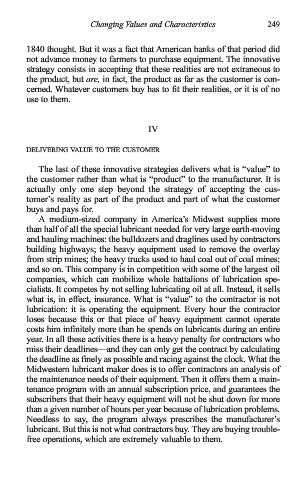Page 256 - ENTREPRENEURSHIP Innovation and entrepreneurship
P. 256
53231_Innovation and Entrepreneurship.qxd 11/8/2002 10:50 AM Page 249
Changing Values and Characteristics 249
1840 thought. But it was a fact that American banks of that period did
not advance money to farmers to purchase equipment. The innovative
strategy consists in accepting that these realities are not extraneous to
the product, but are, in fact, the product as far as the customer is con-
cerned. Whatever customers buy has to fit their realities, or it is of no
use to them.
IV
DELIVERING VALUE TO THE CUSTOMER
The last of these innovative strategies delivers what is “value” to
the customer rather than what is “product” to the manufacturer. It is
actually only one step beyond the strategy of accepting the cus-
tomer’s reality as part of the product and part of what the customer
buys and pays for.
A medium-sized company in America’s Midwest supplies more
than half of all the special lubricant needed for very large earth-moving
and hauling machines: the bulldozers and draglines used by contractors
building highways; the heavy equipment used to remove the overlay
from strip mines; the heavy trucks used to haul coal out of coal mines;
and so on. This company is in competition with some of the largest oil
companies, which can mobilize whole battalions of lubrication spe-
cialists. It competes by not selling lubricating oil at all. Instead, it sells
what is, in effect, insurance. What is “value” to the contractor is not
lubrication: it is operating the equipment. Every hour the contractor
loses because this or that piece of heavy equipment cannot operate
costs him infinitely more than he spends on lubricants during an entire
year. In all these activities there is a heavy penalty for contractors who
miss their deadlines—and they can only get the contract by calculating
the deadline as finely as possible and racing against the clock. What the
Midwestern lubricant maker does is to offer contractors an analysis of
the maintenance needs of their equipment. Then it offers them a main-
tenance program with an annual subscription price, and guarantees the
subscribers that their heavy equipment will not be shut down for more
than a given number of hours per year because of lubrication problems.
Needless to say, the program always prescribes the manufacturer’s
lubricant. But this is not what contractors buy. They are buying trouble-
free operations, which are extremely valuable to them.

